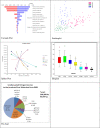The principles and methods behind EFSA's Guidance on Uncertainty Analysis in Scientific Assessment
- PMID: 32625670
- PMCID: PMC7009645
- DOI: 10.2903/j.efsa.2018.5122
The principles and methods behind EFSA's Guidance on Uncertainty Analysis in Scientific Assessment
Abstract
To meet the general requirement for transparency in EFSA's work, all its scientific assessments must consider uncertainty. Assessments must say clearly and unambiguously what sources of uncertainty have been identified and what is their impact on the assessment conclusion. This applies to all EFSA's areas, all types of scientific assessment and all types of uncertainty affecting assessment. This current Opinion describes the principles and methods supporting a concise Guidance Document on Uncertainty in EFSA's Scientific Assessment, published separately. These documents do not prescribe specific methods for uncertainty analysis but rather provide a flexible framework within which different methods may be selected, according to the needs of each assessment. Assessors should systematically identify sources of uncertainty, checking each part of their assessment to minimise the risk of overlooking important uncertainties. Uncertainty may be expressed qualitatively or quantitatively. It is neither necessary nor possible to quantify separately every source of uncertainty affecting an assessment. However, assessors should express in quantitative terms the combined effect of as many as possible of identified sources of uncertainty. The guidance describes practical approaches. Uncertainty analysis should be conducted in a flexible, iterative manner, starting at a level appropriate to the assessment and refining the analysis as far as is needed or possible within the time available. The methods and results of the uncertainty analysis should be reported fully and transparently. Every EFSA Panel and Unit applied the draft Guidance to at least one assessment in their work area during a trial period of one year. Experience gained in this period resulted in improved guidance. The Scientific Committee considers that uncertainty analysis will be unconditional for EFSA Panels and staff and must be embedded into scientific assessment in all areas of EFSA's work.
Keywords: guidance; principles; scientific assessment; uncertainty analysis.
© 2018 European Food Safety Authority. EFSA Journal published by John Wiley and Sons Ltd on behalf of European Food Safety Authority.
Figures





























References
-
- Albert I, Espié E and de Valk H, 2011. A Bayesian evidence synthesis for estimating campylobacteriosis prevalence. Risk Analysis 31, 1141–1155. - PubMed
-
- ANSES , 2016. Avis de l'Anses. Rapport d'expertise collective. Prise en compte de l'incertitude en évaluation des risques: revue de la literature et recommandations pour l'Anses. Available online: https://www.anses.fr/en/system/files/AUTRE2015SA0090Ra.pdf
-
- ARASP (Center for Advancing Risk Assessment Science and Policy), 2015. Workshop on Evaluating and Expressing Uncertainty in Hazard Characterization, Society of Toxicology (SOT) Annual Meeting. Available online: blog.americanchemistry.com/2015/04/what‐you‐may‐have‐missed‐at‐sot‐how‐s...
-
- Arunraj NS, Mandal S and Maiti J, 2013. Modeling uncertainty in risk assessment: an integrated approach with fuzzy set theory and Monte Carlo simulation. Accident Analysis and Prevention, 55, 242–255. - PubMed
-
- Bailer AJ, Noble RB and Wheeler MW, 2005. Model uncertainty and risk estimation for quantal responses. Risk Analysis, 25, 291–299. - PubMed
LinkOut - more resources
Full Text Sources
